This Week You Will Learn:
- Possibly a couple new scary movie titles for your watchlist
- Which social ills can be cured by alien invasion
- At least two reasons why Gus Van Sant’s Psycho remake doesn’t suck
- Which 70s classic is “an unconscionably good time”
- Culture’s greatest loss to date in the Dreamworks v. Disney IP battles.
Send articles throughout the next week to ploughmanplods [at] gmail, post articles from the past week below for discussion, and Have a Happy Friday!
Reverse Shot continues their Halloween tradition of horror film recommendations. This year includes Lord Shango, Malignant, Dracula, and Ghost Story of Yotsuya, the last introduced via the Solute’s current Year of the Month:
The unforgivingly color-drenched Jigoku was one of many films from 1960 that busted cinematic horror wide open, a year that included Hitchcock’s Psycho, Franju’s Eyes without a Face, Wolf Rilla’s Village of the Damned, Powell’s Peeping Tom, Bava’s Black Sunday, and John Moxey’s Horror Hotel, and pointed toward a new era of both permissiveness in gore and discomfiting psychological intensity. But just one year earlier, Nakagawa had directed a more traditional ghost story that was, in some ways, the stylistic equal of Jigoku and offered its own brand of gut-punch creepshow theatrics. Based on a famous, commonly adapted Japanese horror tale that had originated in Kabuki in the early 19th century, Ghost Story of Yotsuya is a classic tale of revenge from beyond the grave that was one of nine horror movies that genre journeyman Nakagawa made for Shintoho studio throughout the 1950s. In the various versions of the Yotsuya ghost fable there have been crucial character and plot differences, yet the main thrust remains the same: a lowly, masterless ronin named Iemon, treacherous in his own right yet also under the influence of an evil Iago-like sidekick Naosuke, wishes to divorce the poor, innocent Oiwa for a younger woman; with Naosuke’s guidance, he decides to frame her as an adulteress before murdering her with disfiguring poison. It will come as no surprise that Oiwa returns to earth as a furious avenging spirit.
For Slate, Tyler Austin Harper muses on the sci-fi tradition of invading aliens solving racism on planet Earth:
Yet, for all that, Invasion remains an interesting cultural document because it is doing something different from the great bulk of science fiction out there about what happens when creatures from another galaxy show up on our doorsteps. Namely, it presents a world in which the arrival of space invaders does not magically fix race or class divides by uniting the human race against a common enemy, a trope that has now been a staple of science fiction for more than a century. From H.G. Wells’ 1897 classic War of the Worlds, in which a Martian attack on London (temporarily) obliterates social hierarchies, to the budding friendship between a Black exotic dancer and a white first lady in Independence Day, aliens have long been imagined as a panacea for prejudice, serving to remind us that—compared with the little green men—we’re not that different after all.
At The Reveal, Keith Phipps comes across Walking Tall Part 2 in his DVD collection and runs the whole revenge-soaked series based on a “true story”:
It’s tough to call Walking Tall a good film, but it’s a highly effective one, made with enough manipulative skill to draw in even those on guard against bullshit. There’s always been a dark side to Roger Ebert’s famous description of movies as “empathy machines.” They can also make viewers empathetic to despicable acts.
Mel Magazine, which apparently snuck back into existence, offers Chingy Nea’s defense of Gus Van Sant’s 1998 Psycho remake:
The thing is, the Van Sant version is nowhere near the trainwreck contemporary viewers and critics made it out to be. Shot by Hong Kong cinematographer Cristopher Doyle (known best for his frequent collaborations with Wong Kar-wai), the film makes excellent use of light, color and bloody imagery in a way its black-and-white predecessor couldn’t. And while it never strays far from Hitchcock’s shots, the recreations feel different the second time around. It plays heavily with familiarity, with the original’s famous shower scene showing a number of differences, all of which pop out like cutaways of storm clouds or a holographically patterned curtain.
Finally, Nathan Rabin wonders whither the Crypt-Keeper at his Happy Place:
At the risk of hyperbole, The Crypt-Keeper is probably the single greatest creation in human history, including all of William Shakespeare’s characters. The Crypt-Keeper was so beloved and so inspired that he spawned the kid-friendly spin-offs Tales From the Crypt-Keeper and Secrets of the Crypt-Keeper’s Haunted House despite Tales From the Crypt being a hard-R rated celebration of profanity, violence and gratuitous nudity.

